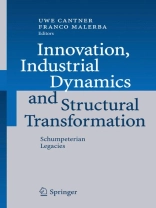The general theme of the 10th International Joseph A. Schumpeter Society Conf- ence, held during June 9th–12th, 2004 at Universita` Luigi Bocconi, Milan, was the exploration of the dynamics of industries driven by the highly interrelated processes of innovation and of structural transformation. The phenomena addressed are at the core of Schumpeter’s work and the discussion of these endogenously created modes of change constitutes one of the major Schumpeterian legacies of today. Indeed, the in?uence of the Schumpeterian approach to economic dynamics is far reaching and covers evolutionary as well as neoclassical theories. This book provides an account of work in the Schumpeterian and evolutionary tradition of industrial dynamics and the evolution of industries. Here, the main analytical concern is that, over time, industries evolve and change their structure, and that, in this dynamic process, knowledge and technologies, the capabilities and incentives of actors, new products and processes (as well as variants of existing ones), and institutions affect and constrain change, sometimes smoothly and so- times in a radical way. Thus, what is meant here by the term structure and structural change is not the traditional market structure view (as re?ected, for example, in the classical discussion of the Schumpeterian Hypotheses), but all those elements and relations between actors, knowledge and technologies which drive innovative activities and greatly affect economic performance in an industry.
Jadual kandungan
Innovation, entrepreneurship, the firm and industry evolution.- Innovation and the evolution of industries.- Entrepreneurship, evolution and the human mind.- Division of labor and division of knowledge: Why the nature of the causality matters for the evolutionary theory of the firm.- Entry of new firms and small firms.- Young firm growth in high-tech sectors: The role of founders’ human capital.- Product entry in a fast growing industry: The LAN switch market.- Network externalities and networks of innovators.- Network effects and the choice of mobile phone operator.- Evolving networks of inventors.- Why do firms disclose knowledge and how does it matter?.- Innovation and competitiveness in local SMEs: Characteristics of firms, entrepreneurs, environment and their interrelationships.- Innovation and industrial transformation in various sectors.- New combinations in old industries: The introduction of radical innovations in tire manufacturing.- Fitness determinants in creative industries: A longitudinal study on the Hollywood film-making industry, 1992–2003.- The selection environment for gas to liquids technology and technological strategies: Challenging the natural trajectory.- Innovation and employment in Europe: A sectoral perspective.- Knowledge diffusion, spillovers and firm strategies.- A laboratory experiment of knowledge diffusion dynamics.- To innovate or to transfer?.- Dynamic gap bridging and realized gap set development: The strategic role of the firm in the coevolution of capability space and opportunity space.- Patents — patenting strategies and impacts of patents.- Innovation strategy and the patenting behavior of firms.- Effects of patenting behavior on corporate growth: A panel data analysis of German start-up firms.- Public Policy — competitionpolicy and the patent system.- What’s the aim for competition policy: Optimizing market structure or encouraging innovative behaviors?.- Social and technological efficiency of patent systems.












